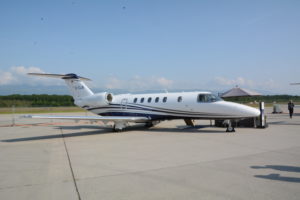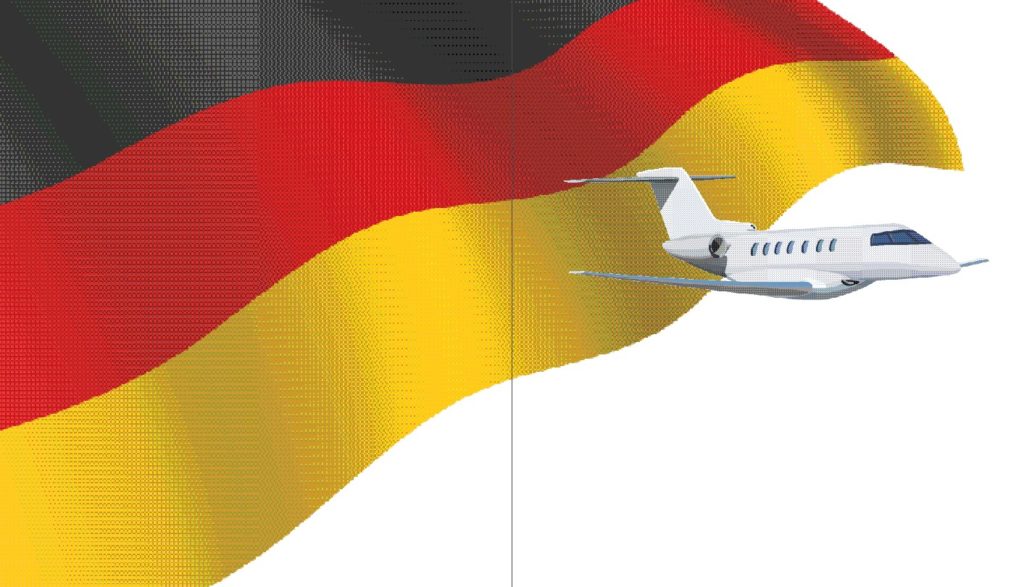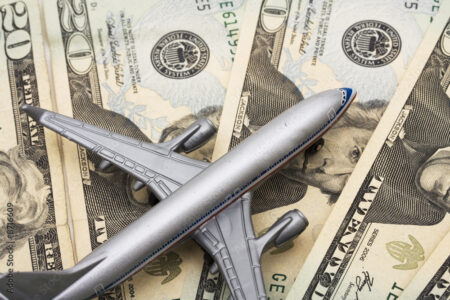Words by Volker K. Thomalla
Business aviation makes a significant contribution to the national economy in Germany. The sector is diverse not only in terms of the number of aircraft and aircraft types, but also in terms of business models. No other European country has more business jets stationed, although the number of operators with AOCs is declining.
Germany is an export-oriented nation – in 2022 the country imported €1.5 billion (US$1.6 billion) of goods and services from all over the world and had exports worth €1.6 billion (US$1.7 billion). This level of trade requires an efficient transport infrastructure, including all types of air traffic. In addition, Germans also travel a lot for tourism not only in their own country, but also in Europe and around the world. The 23 largest airports in Germany recorded 155 million passengers last year.
Without appropriate mobility services that enable networking in a globalized world, the prosperity that has been achieved cannot be maintained. Business aviation is an indispensable part of this transport infrastructure.
Germany has the largest fleet of business aircraft in Europe. There are currently 724 business jets registered in the German aviation register at the Federal Aviation Authority (LBA) in Braunschweig, including: 255 turboprop powered aircraft such as the Pilatus PC-12 or Beechcraft King Air; 269 light jets, for example the Cessna Citation CJ; 76 midsize jets such as the Bombardier Challenger 300; 113 large cabin jets like the Dassault Falcon 7X, and 11 bizliners – airliners converted into business jets.
However, as in other countries, business aviation in Germany also includes aircraft that are based in Germany but registered in other countries such as the USA, Malta, San Marino or Guernsey.
Germany’s fleet

According to surveys by the aviation data analysis company Jetnet IQ and the EBAA (European Business Aviation Association), the business aircraft fleet stationed in Germany consists of a total of 788 aircraft: 288 turboprops, 283 light jets, 79 midsize jets, 127 large cabin jets and 11 bizliners. This represents almost 20% of the whole European fleet. This also puts business aviation in Germany at the top of the list in Europe. There are 499 business jets permanently based in the UK, 497 in France and 237 in Switzerland.
Speaking at the AERO air show in Friedrichshafen, Germany in April Arthur Thomas, market and business intelligence senior manager at the EBAA said, “Business aviation is highly important for domestic connections. Airlines serve 50 destinations and 450 city pairs in Germany, while business aviation serves 225 airports with about 2,500 city pairs.”
Despite its fleet size, the business aviation sector in Germany is less active than that it is in France and the UK. In 2022, French business jets produced a total of 258,222 aircraft movements, 206,151 in the UK and in Germany 187,496. Compared to 2019, the last full year of flights before the Covid-19 crisis, the number of aircraft movements increased 36% in France last year, 9% in the UK and 17% in Germany.
54% of business aviation aircraft movements in Germany last year were commercial, 35% were non-commercial, and the remainder were split between diplomatic and humanitarian flights.
In addition, German airports do not appear in the Top 10 list for business airports in Europe. The reason for this is obvious, as business aviation in Germany is dominated by small and medium-sized companies. The sector fulfils the role of helping these companies compensate for any location disadvantages by offering individual and time-saving transport solutions.
Looking at the routes served by German business jets, the EBAA found that 44% are domestic flights, 54% are to destinations outside Germany but within Europe, and only 2% are to non-European destinations.
However, large corporations such as car manufacturers BMW and VW based in Germany have many engineering development centers and production facilities and are also users of business aviation, or have their own flight departments. Since teams regularly have to commute between different plants, they save significant time by using business jets compared to using other means of transportation, including airlines.
Efficiency gains

Roughly speaking, Germany measures just over 1,000km (630 miles) from north to south – Flensburg to Garmisch-Partenkirchen, and 725km (450 miles) west to east – Aachen to Görlitz. Despite a largely developed network for high-speed trains and highways, many communities are not well connected. Business travel to such destinations requires a large amount of time to arrive and depart, which can be dramatically reduced with a business aircraft. This quickly turns a multi-day trip into a one-day trip, saving time and money and enabling more efficient work practices.
Sports teams also appreciate the advantages of business aviation in Germany. They use aviation to fly to away games. This is not because it is convenient, but because for many teams today schedules are so tight that only the time saved by using the aircraft enables the recovery time needed to compete at a high level.
According to the EBAA, humanitarian flights account for about 8 to 9% of all business jet flights in Europe. These include repatriation flights of the seriously injured and/or patients from abroad, flights of teams of medical professionals for transplant operations, patients and organs, and flights of relatives.
Germany is home to FAI Aviation Group, Unicair, DRF Luftrettung and ADAC Ambulanz-Service, amongst several others. These aviation companies are specialized in these type of challenging medical missions. They are also form a major part of the business aviation community in Europe and Germany.
Lower emissions target
The business aviation industry’s representative body in Germany is the GBAA (German Business Aviation Association), an association with around 100 members.
Speaking at the AERO event in Friedrichshafen Andreas Mundsinger, the CEO of the GBAA said “By strengthening Germany’s decentralized aviation infrastructure we network medium-sized companies and act as an interface between our members, the authorities, state institutions and aviation associations.
“As a competent partner, we engage in active dialogue with policymakers and the scientific community and are committed to climate protection. In a consensus of ecology and economy, we promote the development of lower emission aircraft, alternative fuels and the optimization of operational processes, and aim to be a pioneer in sustainable and effective action by 2030.”
Last year, the GBAA together with the Regional Airfield Association IDRF (Interessengemeinschaft der regionalen Flugplätzen) launched the Innovate2Fly – High Ambitions, Low Emissions initiative. This innovation program aims to lead the way making aviation climate-neutral, a route that will require a high level of investment in innovation.
Substantial investments are also needed to dramatically increase the available quantity of sustainably produced fuel SAF. Currently, demand for SAF exceeds demand many times over in Germany, and SAF is also still significantly more expensive to produce than fuel from fossil sources.
In response, one of Innovate2Fly’s aims is to help establish SAF in aviation. Instead of making compensation payments that do not contribute to any reduction in emissions in Europe, the funds acquired through Innovate2Fly will be used to finance projects that lead to a direct reduction in emissions. However, the program will also continue to support projects that offset emissions by planting trees, for example. In addition to electric flight projects, Innovate2Fly will also support projects to develop alternative fuels.
Although business aviation in Germany contributes significantly to connectivity, thus securing jobs and prosperity it has also come under fire from activists who would prefer to ban it completely and are openly calling for this.
A recent negative highlight of this activism was an action on the island of Sylt in the North Sea, where on June 6 demonstrators cut the airport fence and smeared paint all over a Cessna Citation CJ1. Damage to the aircraft was estimated to be more than €250,000 (US$270,000).
Workforce shortages

The business aviation sector in Germany also sees another threat looming – a shortage of skilled workers. There is already a shortage of pilots, technicians and administrative staff. This shortage is expected to continue to grow and put a strain on the industry. The demands on personnel are high and training is time-consuming and costly. It does not help that the industry is also characterized by comprehensive regulations and safety rules. In addition, another challenge is that the industry is characterized by extensive regulations and safety rules, and that irregular working hours are the norm. But the industry is taking on the challenge of attracting new staff and is developing strategies and initiatives to counter the threat.
In 2022, the number of aviation companies in Germany reached its lowest level since 1998. Only 104 aviation companies had an Air Operator Certificate (AOC) registered with the German Federal Aviation Authority at the end of the year.
On the one hand, the industry is going through a period of consolidation. Evidence of this is that the average fleet size of business aviation companies is increasing. On the other hand, within the EASA states it is possible for companies to hold their AOC in another EU country without any problems. However, despite an increase in air traffic and a growth in the fleet, the number of commercial business aircraft operators is clearly decreasing





